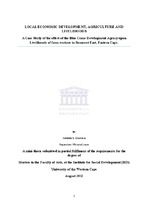| dc.description.abstract | A total of 25 million South Africans are living in poverty, the majority of them in rural areas (SPII, 2007) added to this, the percentage of people living in poverty in rural areas more than doubles those living in the same conditions in an urban context (Armstrong, Lekezwa & Siebrits, 2008). Alleviating poverty and promoting development in rural areas is Strategic Priority no.3 in the National Government’s medium term strategic framework, through the Comprehensive Rural
Development Programme (DRDLR, 2010). It has also been shown that poverty alleviation through small-scale agricultural projects can be successful in both creating income and improving household nutrition (Lahiff, 2003). The South African Government has attempted multiple varied approaches towards poverty
alleviation in rural South Africa with mixed success. One of these approaches is that of a formalised strategy for Local Economic Development (LED) at the municipal government level. LED has been placed firmly in the remit of local government and in some areas has been undertaken by LED agencies (LEDAs) which are autonomous entities but are operating within municipal legal structures. The Blue Crane Development Agency (BCDA) is one such LEDA based in the Blue Crane Route Municipality of the Cacadu District of the Eastern Cape. The main aim of this study is to explore how the BCDA’s agricultural projects affected the livelihoods of their participant communities. The study utilises the Sustainable Livelihoods Approach (SLA) in order to measure primarily qualitative differences the LED program has made to local livelihood strategies and outcomes. The research takes the form of a case-study, utilising in depth interviews and Participatory Rural Appraisal (PRA) tools. It was found that the agricultural LED projects did increase livelihoods and capital during the time they were ongoing. However, as the projects had ended there was no long term increase to livelihood strategies and security. Multiple factors were responsible for the project failures. These include the lack of clear delineation in roles between the BCDA and their employees, lack of re-investment once projects were inherited by the beneficiaries and insufficient post hand-over mentoring. | en_US |

